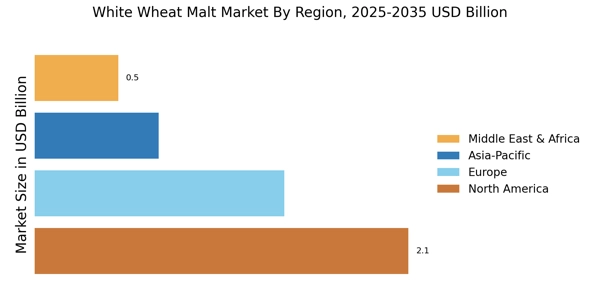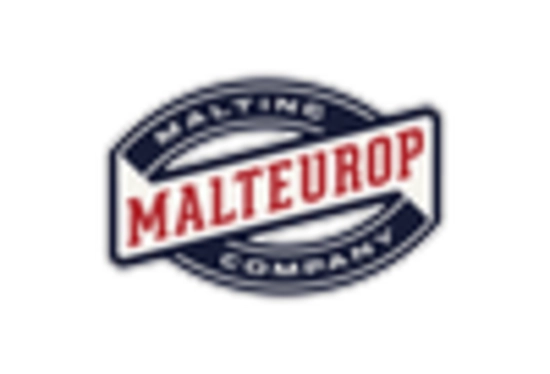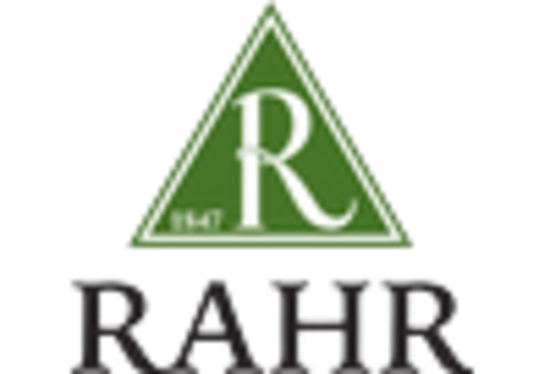Expansion of Craft Breweries
The proliferation of craft breweries is a significant driver for the White Wheat Malt Market. As new craft breweries continue to emerge, there is an increasing demand for diverse malt options, including white wheat malt. This trend is supported by data indicating that the number of craft breweries has more than doubled in recent years, creating a competitive landscape that encourages innovation and experimentation. Craft brewers often seek unique ingredients to differentiate their products, and white wheat malt offers distinct flavor characteristics that can enhance their offerings. The expansion of craft breweries not only boosts the demand for white wheat malt but also fosters a culture of creativity within the industry. As this trend continues, the White Wheat Malt Market is expected to grow in tandem with the craft brewing sector, potentially leading to new product developments and market opportunities.
Innovations in Brewing Technology
Technological advancements in brewing processes are significantly impacting the White Wheat Malt Market. Innovations such as improved malting techniques and fermentation processes are enabling brewers to enhance the quality and efficiency of their products. For instance, the introduction of automated malting systems has streamlined production, allowing for greater consistency in malt quality. Additionally, advancements in yeast strains and fermentation technology have opened new avenues for flavor development in beers made with white wheat malt. These innovations not only improve the brewing process but also contribute to the overall growth of the market. As breweries adopt these technologies, the White Wheat Malt Market is likely to experience increased demand for high-quality malt, which can meet the evolving needs of both brewers and consumers.
Health-Conscious Consumer Behavior
In recent years, there has been a marked shift in consumer behavior towards health-conscious choices, which has implications for the White Wheat Malt Market. Consumers are increasingly seeking products that align with their health and wellness goals, including those that are perceived as healthier alternatives. White wheat malt, known for its lower gluten content compared to traditional barley malts, appeals to a segment of the population that is sensitive to gluten. This trend is reflected in the growing market for gluten-free and health-oriented beverages, which has seen a rise of approximately 15% in sales. As more consumers gravitate towards healthier options, the White Wheat Malt Market is likely to see an uptick in demand for products that cater to these preferences, thereby influencing production strategies and marketing approaches.
Rising Popularity of Specialty Beers
The White Wheat Malt Market is experiencing a notable surge in the popularity of specialty beers, particularly those that utilize white wheat malt as a key ingredient. This trend is driven by consumers' increasing preference for unique flavors and artisanal products. According to recent data, the craft beer segment has expanded significantly, with a reported growth rate of approximately 10% annually. This growth is likely to continue as breweries seek to differentiate their offerings. The incorporation of white wheat malt not only enhances the flavor profile but also contributes to the mouthfeel and appearance of the beer, making it a favored choice among brewers. As the demand for specialty beers rises, the White Wheat Malt Market is poised to benefit from this trend, potentially leading to increased production and innovation in malt varieties.
Sustainability and Environmental Concerns
The White Wheat Malt Market is increasingly influenced by sustainability and environmental concerns. As consumers become more aware of the ecological impact of their choices, there is a growing demand for sustainably sourced ingredients in the brewing process. White wheat malt, when produced using environmentally friendly practices, can appeal to this conscientious consumer base. Many breweries are now prioritizing sustainable sourcing and production methods, which not only enhance their brand image but also align with consumer values. This shift towards sustainability is reflected in market trends, with a reported increase in sales of products labeled as organic or sustainably produced. As the industry moves towards greener practices, the White Wheat Malt Market is likely to benefit from this trend, potentially leading to increased market share for sustainably produced white wheat malt.


















Leave a Comment